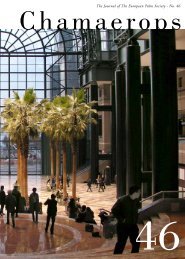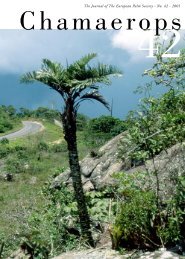Download - The European Palm Society
Download - The European Palm Society
Download - The European Palm Society
Create successful ePaper yourself
Turn your PDF publications into a flip-book with our unique Google optimized e-Paper software.
you understand nevertheless. I always like theprefaces in ‘Chamaerops‘ best. I‘m a great fan ofTrithrinax acanthocoma. I bought one such palmover 4 years ago and now it is almost 1 meterhigh. Last spring, after a long winter, it was clearthat it had suffered. <strong>The</strong> new sprout was brown,and during the summer the palm grew really shortfronds. Was this caused by dryness in winter or,perhaps, not having the right pH value aftertransplanting it to a new pot?I‘d like to write an article about all my plants,palms and banana trees, for Chamaerops soon.For today, thank you very much and many kindregards.Helga Baumgartner, Burghausen, Germany.Trithrinax acanthocoma is very tolerant tovarying pH levels in the soil, so I‘m sure this wasnot the problem. It is more likely that dryness inthe soil or prolonged exposure to cold and dampconditions was the cause. (ts)Uxbridge TrachycarpusI am writing to report on the marvelous standof Trachycarpus fortunei growing in the groundsof Brunel University at Uxbridge.I should explain that my wife and I met atBrunel in the mid-1970s where we both studiedChemistry, and although we have lived in the areasince graduating, we have rarely returned to thecampus. However, in April this year we attendeda Chemistry Department reunion, along withBrunel graduates from the past 40 years, whichgave us the opportunity to have a good lookround.<strong>The</strong> weather was awful, cold and wet, andmade more depressing by the news of theimminent closure of the Chemistry Department,after 50 years at Uxbridge. <strong>The</strong>refore, imagineour pleasure on finding that those "strange spikyplants" we remembered in the grass in front ofthe Biology-Chemistry building had grown intoa fine stand of 22 Trachycarpus fortunei!<strong>The</strong>se are planted in two informal groups atthe western end of the building, with a doublerow of 14 plants towards the east. All enjoy asoutherly aspect and are protected by the buildingfrom the occasional cold north wind. As can beseen from the enclosed photographs, the plantsare in fine condition and the abundant fruitindicates that they had all flowered the previousyear.I should add that in the 1970s I hadabsolutely no interest in palms and had, alongwith almost everyone else at Brunel, dismissedthese "strange" plants and imagined that theywould soon succumb to the cold. <strong>The</strong>re musthave been at least one palm enthusiast since. Iunderstand that the young plants were given tothe university by one of the professors. <strong>The</strong> lessonfor all of us palm enthusiasts, (and others), is ofcourse, that Trachycarpus fortunei and manyother "hardy" palms can grow into magnificentfeatures given sufficient time and favourableconditions. <strong>The</strong>y certainly do an excellent job ofhiding the otherwise unattractive concrete andglass buildings at Brunel.Hopefully other institutions and localauthorities can be encouraged to plant morepalms now in order to provide a similarlyimpressive spectacle in 25 years time. We willcertainly be returning to the campus later on inthe summer to photograph these palms in flower.N A J Hobbs, Uxbridge, Middlesex, U.K.Send your letters to:<strong>The</strong> <strong>European</strong> <strong>Palm</strong> <strong>Society</strong>c/o <strong>The</strong> <strong>Palm</strong> CentreHam Central NurseryHam Street, HamRichmond, Surrey, TW10 7HA, UKOr by e-mail: mail@palmsociety.orgpage 23










